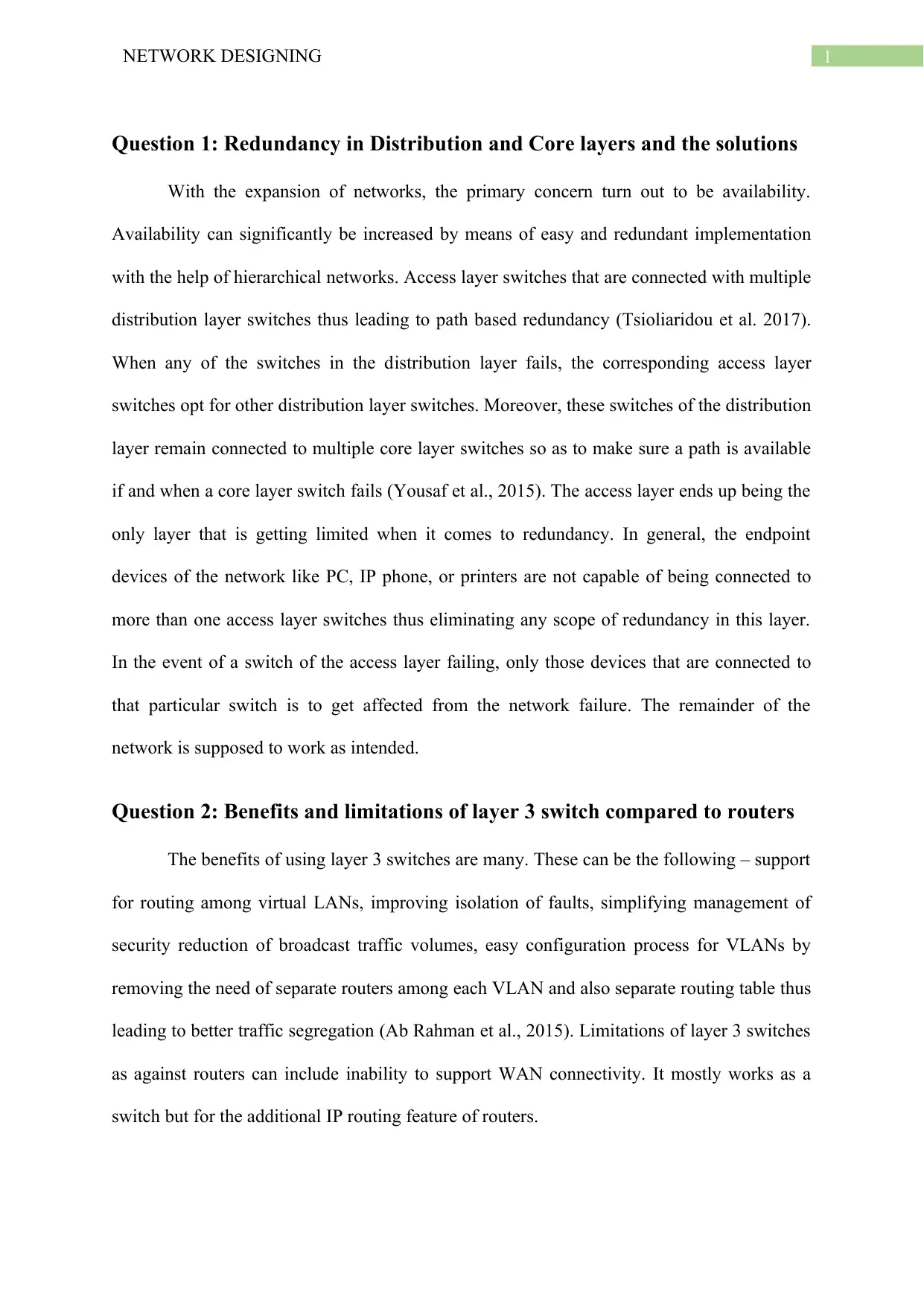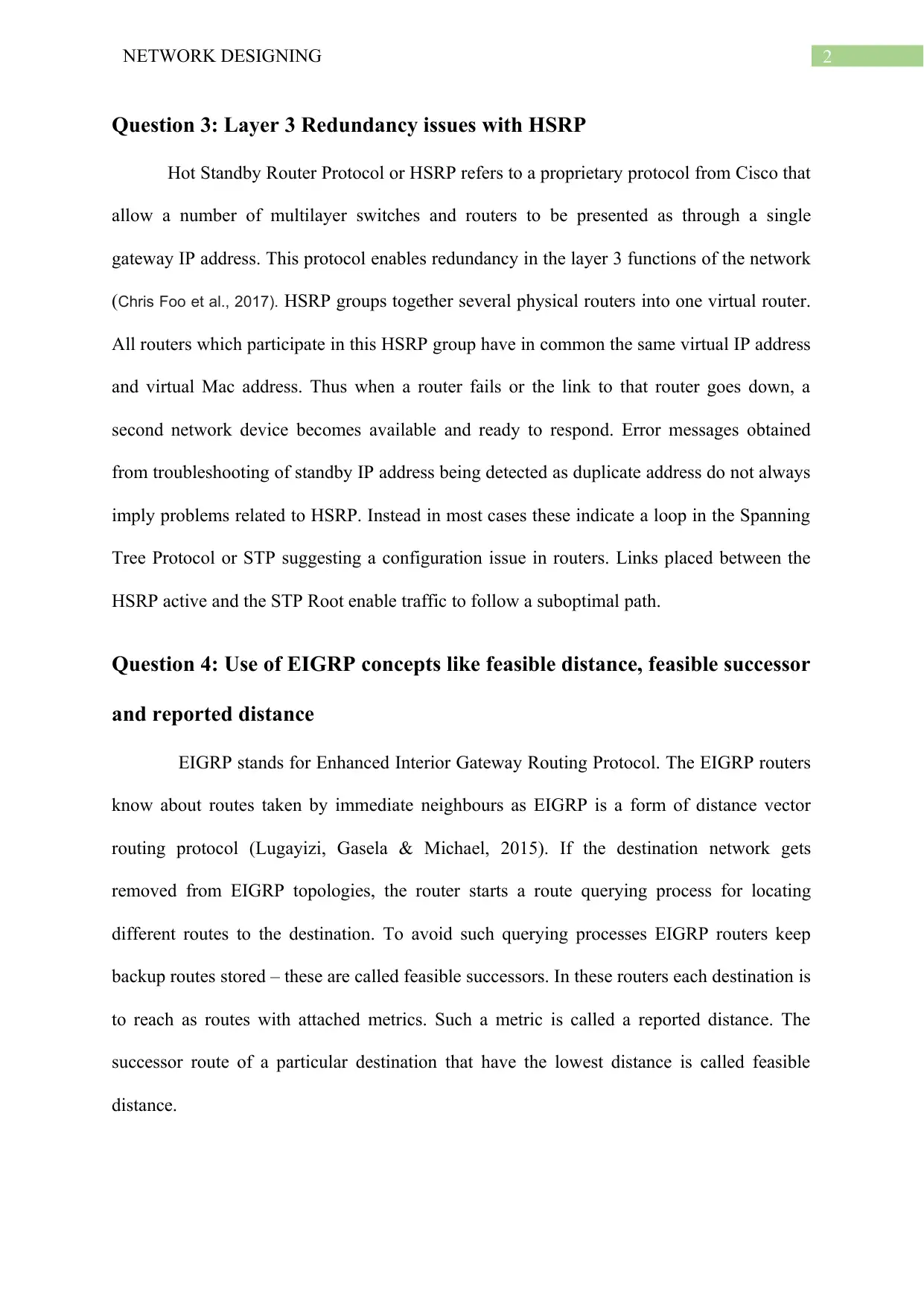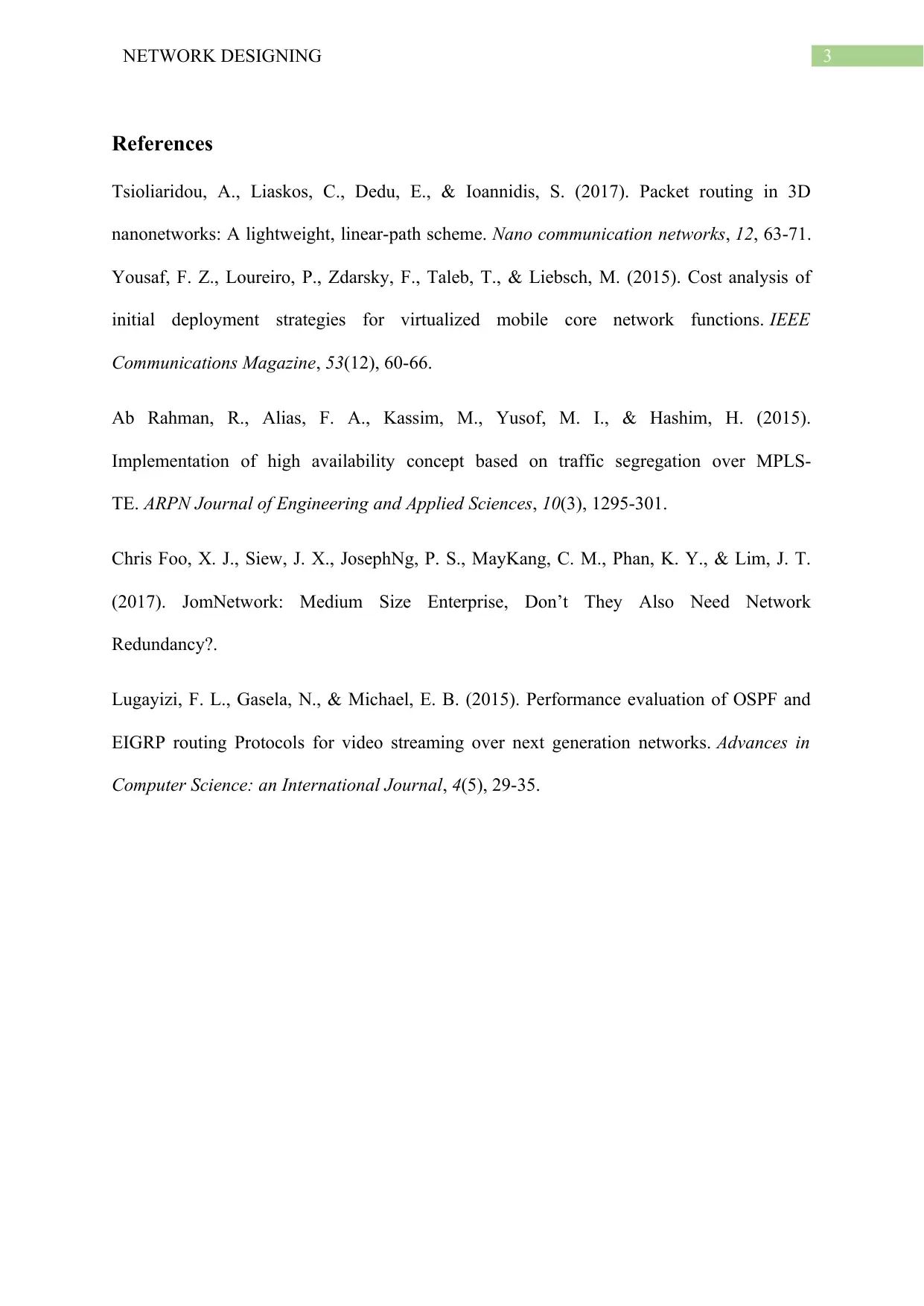Network Design: Redundancy, Layer 3 Switches, HSRP Conflicts & EIGRP
VerifiedAdded on 2023/03/21
|4
|947
|64
Homework Assignment
AI Summary
This assignment delves into critical aspects of network design, focusing on redundancy solutions at the distribution and core layers, comparing Layer 3 switches with traditional routers, addressing HSRP issues in the context of STP, and explaining the use of EIGRP concepts like feasible distance, reported distance, and feasible successor to prevent routing loops. The document highlights the importance of redundancy for network availability, explores the benefits and limitations of Layer 3 switches, discusses potential conflicts between HSRP and STP, and elucidates how EIGRP ensures valid and loop-free paths. This comprehensive analysis provides valuable insights into designing robust and efficient network infrastructures. Desklib offers a wealth of similar solved assignments and resources for students seeking to deepen their understanding of network design and related topics.

Running head: NETWORK DESIGNING
Network Designing
Name of the Student
Name of the University
Author Note
Network Designing
Name of the Student
Name of the University
Author Note
Paraphrase This Document
Need a fresh take? Get an instant paraphrase of this document with our AI Paraphraser

1NETWORK DESIGNING
Question 1: Redundancy in Distribution and Core layers and the solutions
With the expansion of networks, the primary concern turn out to be availability.
Availability can significantly be increased by means of easy and redundant implementation
with the help of hierarchical networks. Access layer switches that are connected with multiple
distribution layer switches thus leading to path based redundancy (Tsioliaridou et al. 2017).
When any of the switches in the distribution layer fails, the corresponding access layer
switches opt for other distribution layer switches. Moreover, these switches of the distribution
layer remain connected to multiple core layer switches so as to make sure a path is available
if and when a core layer switch fails (Yousaf et al., 2015). The access layer ends up being the
only layer that is getting limited when it comes to redundancy. In general, the endpoint
devices of the network like PC, IP phone, or printers are not capable of being connected to
more than one access layer switches thus eliminating any scope of redundancy in this layer.
In the event of a switch of the access layer failing, only those devices that are connected to
that particular switch is to get affected from the network failure. The remainder of the
network is supposed to work as intended.
Question 2: Benefits and limitations of layer 3 switch compared to routers
The benefits of using layer 3 switches are many. These can be the following – support
for routing among virtual LANs, improving isolation of faults, simplifying management of
security reduction of broadcast traffic volumes, easy configuration process for VLANs by
removing the need of separate routers among each VLAN and also separate routing table thus
leading to better traffic segregation (Ab Rahman et al., 2015). Limitations of layer 3 switches
as against routers can include inability to support WAN connectivity. It mostly works as a
switch but for the additional IP routing feature of routers.
Question 1: Redundancy in Distribution and Core layers and the solutions
With the expansion of networks, the primary concern turn out to be availability.
Availability can significantly be increased by means of easy and redundant implementation
with the help of hierarchical networks. Access layer switches that are connected with multiple
distribution layer switches thus leading to path based redundancy (Tsioliaridou et al. 2017).
When any of the switches in the distribution layer fails, the corresponding access layer
switches opt for other distribution layer switches. Moreover, these switches of the distribution
layer remain connected to multiple core layer switches so as to make sure a path is available
if and when a core layer switch fails (Yousaf et al., 2015). The access layer ends up being the
only layer that is getting limited when it comes to redundancy. In general, the endpoint
devices of the network like PC, IP phone, or printers are not capable of being connected to
more than one access layer switches thus eliminating any scope of redundancy in this layer.
In the event of a switch of the access layer failing, only those devices that are connected to
that particular switch is to get affected from the network failure. The remainder of the
network is supposed to work as intended.
Question 2: Benefits and limitations of layer 3 switch compared to routers
The benefits of using layer 3 switches are many. These can be the following – support
for routing among virtual LANs, improving isolation of faults, simplifying management of
security reduction of broadcast traffic volumes, easy configuration process for VLANs by
removing the need of separate routers among each VLAN and also separate routing table thus
leading to better traffic segregation (Ab Rahman et al., 2015). Limitations of layer 3 switches
as against routers can include inability to support WAN connectivity. It mostly works as a
switch but for the additional IP routing feature of routers.

2NETWORK DESIGNING
Question 3: Layer 3 Redundancy issues with HSRP
Hot Standby Router Protocol or HSRP refers to a proprietary protocol from Cisco that
allow a number of multilayer switches and routers to be presented as through a single
gateway IP address. This protocol enables redundancy in the layer 3 functions of the network
(Chris Foo et al., 2017). HSRP groups together several physical routers into one virtual router.
All routers which participate in this HSRP group have in common the same virtual IP address
and virtual Mac address. Thus when a router fails or the link to that router goes down, a
second network device becomes available and ready to respond. Error messages obtained
from troubleshooting of standby IP address being detected as duplicate address do not always
imply problems related to HSRP. Instead in most cases these indicate a loop in the Spanning
Tree Protocol or STP suggesting a configuration issue in routers. Links placed between the
HSRP active and the STP Root enable traffic to follow a suboptimal path.
Question 4: Use of EIGRP concepts like feasible distance, feasible successor
and reported distance
EIGRP stands for Enhanced Interior Gateway Routing Protocol. The EIGRP routers
know about routes taken by immediate neighbours as EIGRP is a form of distance vector
routing protocol (Lugayizi, Gasela & Michael, 2015). If the destination network gets
removed from EIGRP topologies, the router starts a route querying process for locating
different routes to the destination. To avoid such querying processes EIGRP routers keep
backup routes stored – these are called feasible successors. In these routers each destination is
to reach as routes with attached metrics. Such a metric is called a reported distance. The
successor route of a particular destination that have the lowest distance is called feasible
distance.
Question 3: Layer 3 Redundancy issues with HSRP
Hot Standby Router Protocol or HSRP refers to a proprietary protocol from Cisco that
allow a number of multilayer switches and routers to be presented as through a single
gateway IP address. This protocol enables redundancy in the layer 3 functions of the network
(Chris Foo et al., 2017). HSRP groups together several physical routers into one virtual router.
All routers which participate in this HSRP group have in common the same virtual IP address
and virtual Mac address. Thus when a router fails or the link to that router goes down, a
second network device becomes available and ready to respond. Error messages obtained
from troubleshooting of standby IP address being detected as duplicate address do not always
imply problems related to HSRP. Instead in most cases these indicate a loop in the Spanning
Tree Protocol or STP suggesting a configuration issue in routers. Links placed between the
HSRP active and the STP Root enable traffic to follow a suboptimal path.
Question 4: Use of EIGRP concepts like feasible distance, feasible successor
and reported distance
EIGRP stands for Enhanced Interior Gateway Routing Protocol. The EIGRP routers
know about routes taken by immediate neighbours as EIGRP is a form of distance vector
routing protocol (Lugayizi, Gasela & Michael, 2015). If the destination network gets
removed from EIGRP topologies, the router starts a route querying process for locating
different routes to the destination. To avoid such querying processes EIGRP routers keep
backup routes stored – these are called feasible successors. In these routers each destination is
to reach as routes with attached metrics. Such a metric is called a reported distance. The
successor route of a particular destination that have the lowest distance is called feasible
distance.
⊘ This is a preview!⊘
Do you want full access?
Subscribe today to unlock all pages.

Trusted by 1+ million students worldwide

3NETWORK DESIGNING
References
Tsioliaridou, A., Liaskos, C., Dedu, E., & Ioannidis, S. (2017). Packet routing in 3D
nanonetworks: A lightweight, linear-path scheme. Nano communication networks, 12, 63-71.
Yousaf, F. Z., Loureiro, P., Zdarsky, F., Taleb, T., & Liebsch, M. (2015). Cost analysis of
initial deployment strategies for virtualized mobile core network functions. IEEE
Communications Magazine, 53(12), 60-66.
Ab Rahman, R., Alias, F. A., Kassim, M., Yusof, M. I., & Hashim, H. (2015).
Implementation of high availability concept based on traffic segregation over MPLS-
TE. ARPN Journal of Engineering and Applied Sciences, 10(3), 1295-301.
Chris Foo, X. J., Siew, J. X., JosephNg, P. S., MayKang, C. M., Phan, K. Y., & Lim, J. T.
(2017). JomNetwork: Medium Size Enterprise, Don’t They Also Need Network
Redundancy?.
Lugayizi, F. L., Gasela, N., & Michael, E. B. (2015). Performance evaluation of OSPF and
EIGRP routing Protocols for video streaming over next generation networks. Advances in
Computer Science: an International Journal, 4(5), 29-35.
References
Tsioliaridou, A., Liaskos, C., Dedu, E., & Ioannidis, S. (2017). Packet routing in 3D
nanonetworks: A lightweight, linear-path scheme. Nano communication networks, 12, 63-71.
Yousaf, F. Z., Loureiro, P., Zdarsky, F., Taleb, T., & Liebsch, M. (2015). Cost analysis of
initial deployment strategies for virtualized mobile core network functions. IEEE
Communications Magazine, 53(12), 60-66.
Ab Rahman, R., Alias, F. A., Kassim, M., Yusof, M. I., & Hashim, H. (2015).
Implementation of high availability concept based on traffic segregation over MPLS-
TE. ARPN Journal of Engineering and Applied Sciences, 10(3), 1295-301.
Chris Foo, X. J., Siew, J. X., JosephNg, P. S., MayKang, C. M., Phan, K. Y., & Lim, J. T.
(2017). JomNetwork: Medium Size Enterprise, Don’t They Also Need Network
Redundancy?.
Lugayizi, F. L., Gasela, N., & Michael, E. B. (2015). Performance evaluation of OSPF and
EIGRP routing Protocols for video streaming over next generation networks. Advances in
Computer Science: an International Journal, 4(5), 29-35.
1 out of 4
Related Documents
Your All-in-One AI-Powered Toolkit for Academic Success.
+13062052269
info@desklib.com
Available 24*7 on WhatsApp / Email
![[object Object]](/_next/static/media/star-bottom.7253800d.svg)
Unlock your academic potential
Copyright © 2020–2025 A2Z Services. All Rights Reserved. Developed and managed by ZUCOL.





